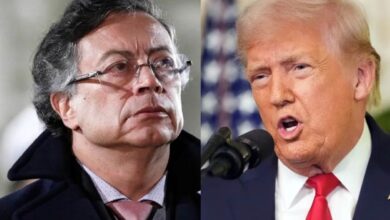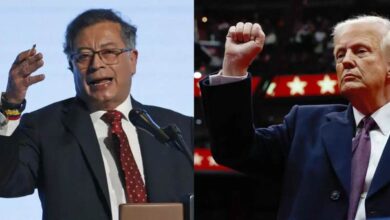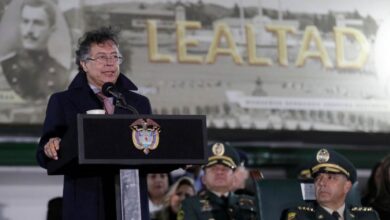Marches across Colombia: What Is the Political Landscape in the Country?
The marches in Colombia for and against the reforms of the government of President Gustavo Petro show us how the political landscape of this country is facing its first left-wing president

Photo: TW-petrogustavo
LatinAmerican Post | July Vanesa López Romero
Escucha este artículo
Leer en español: Marchas en Colombia: ¿qué nos muestran del panorama político en el país?
The 2022 electoral season in Colombia showed that the country is going through a strong political polarization, one that became even more visible with the triumph of Gustavo Petro as the first left-wing president. Seven months after his election, that polarization is still palpable and was present in the marches that took place in the main cities on February 14 and 15. The first, on February 14, was called by Petro himself in order to give a message to the Congress of the Republic after presenting the health reform on Monday, February 13. On February 15, the opposition held a counter-march to show discontent with the reforms that the Petro government has proposed during its mandate. However, in the development of the marches, it became clear that both parties did not achieve a greater impact.
March of February 14
As we already mentioned, the march that Petro called was intended to send a message to Congress: that the Colombian people fervently support the reforms that their government has proposed. However, during the day, this reason was not very clear nor did it have much impact. According to data from the National Police, there were around 28,000 persons in the main cities of the country such as Medellín, Cali, Barranquilla, and Bogotá. This number fell short of the number of people who voted for the Petro. In that order of ideas, this was not a massive march. In fact, it is possible to think that in this march, Petrismo's grassroots movements and unions from the 2021 strike committees were the ones who demonstrated the most.
This mobilization showed us that apparently it is much more difficult to mobilize the people if you are already in power. In general, ordinary people, those who voted for Petro, do not fully understand the impact and both positive and negative consequences of the reforms, beyond not agreeing with them. To a large extent, this blame falls on the way in which the government has communicated, since the reforms were explained without elaborating on them and without addressing how they would be implemented. This was demonstrated, for example, when the Minister of Health, Carolina Corcho, assured that the EPS (Health Promotion Entities) would end, but later retracted it and spoke of "building on what was built" leaving the issue very ambiguous.
Also read: Why Doesn't the Peruvian Congress Want to Advance Elections?
The day ended without any disturbance to public order and with a very "Petrist-style" speech, which the president gave at the reopening of the presidential balcony at the Casa de Nariño. He not only talked about the health reform, but also about labor and pension reform. Petro invited the marches to continue and insisted that this is the only way for the people to make themselves heard. He also assured that the march on February 14 is the beginning of massive mobilizations. However, this first sample does not seem very strong or very convincing.
15F Countermarch
Unlike the march on February 14, the one on February 15 did not have a defined convener. Broadly speaking, it was the opposition who made the call to continue the marches against the Petro reforms, which began in Medellín on Sunday, February 12. According to estimates by the National Police, around 48,500 people mobilized in the main cities of the country, with the greatest influx in Bogotá and Medellín. This march had 20,000 more people than the one on February 14.
Despite the fact that there were many more people, the opposition was disorganized due to several factors. In the first place, it is not very clear who is leading this movement. Faces from the right such as "Pacho" Santos, Miguel Uribe, María Fernando Cabal and Miguel Polo Polo were seen. Likewise, there were Diego Molano and Eduardo Zapateiro, who are already campaigning for the regional elections, but none of them seemed to lead anything. Secondly, when the Plaza de Bolívar was reached in Bogotá, there was neither a stage nor a baffle. Therefore, there was no speech by anyone and the protesters limited themselves to shouting at Congress demanding that Petro show his face and go out to the presidential balcony, when it is a few blocks from the point where the protesters were.
Finally, despite the fact that the marches were supposedly aimed at opposing Petro's reforms, the mobilization seemed more willing to demonstrate anti-Petrism. The harangues and banners of those who protested did not point to the government's decisions, but to Petro, to his presidency and to the left. There were even several protesters who called on the public forces and the army to seize power, that is, to carry out a coup. In addition, the event was attended by pro-life groups that collected signatures for the anti-abortion referendum that plans to submit to congress.
In this sense, those attending the 15F march, which is also intended to be an indefinite national strike, were not very clear about what they were going for, why and how. It was more of a meeting of people against Gustavo Petro convinced that the current government is a dictatorship and that the country is being led by a guerrilla.
An Uncertain Outlook and Unclear Goals
Facing the regional elections in October and the decisions that Congress makes regarding the reforms, it is clear that there is misinformation and ideals that go more against a particular person instead of a search for the well-being of the country, beyond that there is a polarization in Colombia. On the one hand, it is clear that much of the strength and support that Petro received during the elections has waned. In addition, it shows that the way in which his government and cabinet have communicated is jeopardizing what he wants to achieve with the reforms. On the other hand, the opposition is showing that it has no head and that its desire to go against Petro and want to remove him from power reveals its more disorganized and meaningless face.





